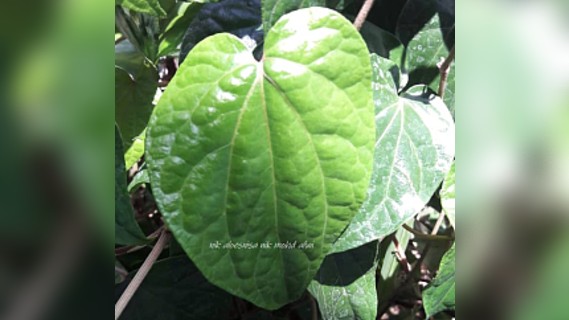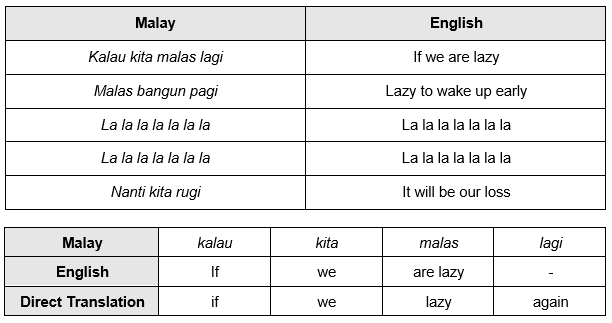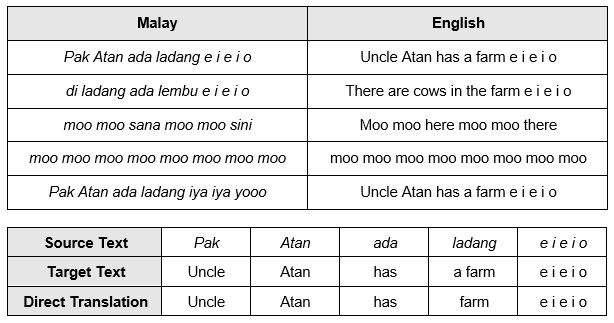Nursery rhymes is an inseparable part of our childhood. Mothers sing nursery rhymes to their children, and early childhood education centres teach children to sing them.
Besides being a fun interactive activity for children, nursery rhymes have also been found to bring multiple benefits to young children, such as the aim to impart knowledge to children through singing its lyrics.
Nursery rhymes contribute to shaping and enhancing a child’s phonological sensitivity, which encourages more success for a child learning to read and spell words (Bryant et al., 1989).
As we have walk into the modern era, traditional nursery rhymes are still an essential part of early childhood around the world because of its familiarity and cultural significance.
Didi and Friends
In this article, we translated two popular nursery rhymes from Bahasa Malaysia (Malay) to English language. The nursery rhymes were extracted from a local children’s television show named Didi and Friends, an animation series owned by Digital Durian Company in Malaysia. It targets preschool kids aged between 0-6 to learn basic knowledge while entertaining them.
Didi and Friends was first aired on Astro Ceria in 2015. It later turned into a mutual collaboration in 2017 with a series called Didi & Friends Stories. It quickly became a hit and in 2018, they had their first cinematic movie entitled “Konsert Hora Horey Didi & Friends”.
The three main characters in Didi & Friend are Didi, Jojo, and Nana. Didi is a male rooster with yellow hair, wearing blue shirt, and blue-red baseball cap. Jojo is the white-haired rooster, wearing green shirt with purple eyeglass. While Nana is a female chicken with grey fur, wearing gown and head ribs with pink colour.
The nursery rhymes sung are often adapted from popular classic nursery rhymes from the West and sung in Bahasa Malaysia. The lyrics of the songs are changed to fit into the Malaysian context.
We decided to translate the lyrics songs from Didi and Friends to English.
Form and Meaning
Translation is the changing of one form to another. As we translate, the meaning of the text is also transferred in this process. Translating songs is never easy. There are many aspects to take into consideration beyond just translating the lyrics from a source language to the target language.
A song must be sung according to its melody, and therein lies the main challenge of song translation. Translators are faced with the struggle of ensuring that the songs’ original form/aesthetic value is retained and can still be sung with its original music after it has been translated.
For nursery rhymes, the form of these familiar tunes should be retained because of the global familiarity that most people would recognise these tunes/melodies. Alternative renditions of nursery rhymes may not be as easily accepted as many have grown up singing and humming the same music passed down from one generation to the next.
Translator should make careful lexical choices to ensure that the meaning of the song in the source text is retained and not distorted.
The problem is: lexical choices may potentially affect the way the song is sung with the tune, or it may not rhyme at all with the whole body of the song.
Children nursery rhymes should have limited set of lexical choices. Translators must bear in mind the varying comprehension levels of children within the range of the target audience. These are the many factors that translators should consider when faced with the challenge of translating songs.
Challenges
One challenge was the inability to achieve the exact meaning which corresponds to the original version of nursery rhymes' melody. Borrowing from English can occur from the absence of Malay terms in conveying the accurate information (Abidin, et al, 2016).
Below are the Malay versions of the nursery rhymes that were translated into English: “Lompat Si Katak Lompat” and “Pak Atan ada Ladang”, both carrying moral values.
Other than “accuracy”, fitting into the melody, tones, and the notes of the original version of nursery rhymes were identified as some of the challenges in trying to create a “singable” version of the popular nursery rhymes in English.
The first verse of the nursery rhymes titled “Lompat Si Katak Lompat” shows the first lyrics “Lompat si katak lompat” gives inaccurate meaning after been translated to English.
Here, “Si katak" is replaced with "little frog" to create a singable, natural, and sensible translation.
The translation of “lagi” was removed here because it will give a different meaning, as well as making it hard to fit into the melody of the original nursery rhymes. The translation for “lagi” in the target text delivers the meaning of the segment.
The grammar
Preserving the grammatical structure in translating Malay text into English could be challenging, for instance in translating nouns.
"Has a farm" is used to produce a grammatically correct structure rather than direct translation.
"There are cows" is used to create “sense” in the target text as "ada lembu" does not clarify the number of cows in the farm.
Grammar is a crucial factor in preserving the meaning, alter, or confusing the target audience in translating song lyrics.
Conclusion
We translated two popular Malay nursery rhymes into English. Our hope is that the twist of lyrics (shifts), changes, and adaptation into the Malaysian context would appeal to the wider audience.
The challenges faced in the process proves that song translation is mainly difficult due to the difficulties in creating a balance between the form, pronunciation, syllables, lexicon, accuracy, grammaticality, sense, rhyme, and other aesthetic features.
Therefore, refinement and tuning are always required in identifying and polishing the appropriate equivalence in translating nursery rhymes, whereby translator creativity, such as what is expected from a poet, plays a significant role in the construction of a “singable” translation.
Acknowledgement
I would like to thank Azlin Nur Ain Binti Azman and Lim Ming Ern from the Faculty Of Social Sciences and Liberal Arts; UCSI University Malaysia for their sincere contribution to this study.
References
Bryant, P. E., Bradley, L., Maclean, M., & Crossland, J. (1989). Nursery rhymes, phonological skills and reading. Journal of Child Language, 16(2), 407–428. https://doi.org/10.1017/S0305000900010485
Abidin, N. Z., Ismayatim, W. F., & Yee, W. (2016). English to Malay (Bahasa Melayu) translation: Syntactical issues involving time reference. International Journal of Humanities and Social Science Invention, 5(9), 58-68.



















